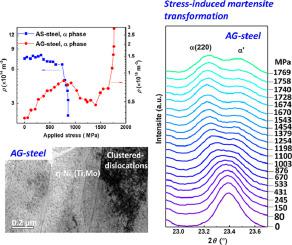International Journal of Plasticity ( IF 9.4 ) Pub Date : 2023-04-11 , DOI: 10.1016/j.ijplas.2023.103612 Hu Li , Yong Liu , Weijiang Zhao , Bin Liu , Aki Tominaga , Takehisa Shobu , Daixiu Wei

|
This work aims at revealing the deformation mechanism of a newly developed Fe-18Ni-5Mo-2Cr-1.2Ti-0.6 V maraging steel with high strength and good ductility via in-situ synchrotron X-ray diffraction and transmission electron microscopy. High-density dislocation and nanometer-scaled precipitates were found in the lath martensite. Dislocation density decreased sharply in the as-solution-annealed steel (AS-steel), leading to massive austenite transformed into martensite on loading. Deformation results in massive dislocation proliferation, and lattice strain linear increase in aged steel (AG-steel). It was verified that even high dislocation density in AS-steel cannot be preserved after deformation due to the lack of pinning effect of dislocation slip. The plastic deformation of the crystals in AG-steel is attributed to the interaction between the nanometer-scaled Ni3(Ti, Mo) precipitates and the dislocations, obeying the Orowan mechanism. The pre-formed martensite in the AG-steel was transformed into a fresh orthogonal phase when the applied stress was above ∼876 MPa. The hard lath martensite can bear a higher level of applied stress during deformation; however, the lattice strain of austenite is much lower than that of martensite. Stress-induced martensitic transformation and dislocations proliferation were jointed to mediate the plastic deformation. And thus, the AG-steel exhibits a high work hardening rate, high strength of up to ∼1700 MPa, and an elongation of more than 11.7%.
中文翻译:

使用原位 X 射线同步辐射研究强韧马氏体时效钢的变形机制
这项工作旨在通过原位揭示新开发的高强度和良好延展性的 Fe-18Ni-5Mo-2Cr-1.2Ti-0.6 V 马氏体时效钢的变形机制同步加速器 X 射线衍射和透射电子显微镜。在板条马氏体中发现了高密度位错和纳米级析出物。固溶退火钢(AS 钢)中的位错密度急剧下降,导致块状奥氏体在加载时转变为马氏体。变形导致大量位错扩散,以及时效钢(AG 钢)中的晶格应变线性增加。经证实,由于缺乏位错滑移的钉扎效应,即使 AS 钢中的高位错密度在变形后也无法保留。AG 钢中晶体的塑性变形归因于纳米级 Ni 3之间的相互作用(Ti, Mo)析出物和位错,服从Orowan机制。当施加的应力高于~876 MPa 时,AG 钢中的预成型马氏体转变为新的正交相。硬质板条马氏体在变形时能承受较高的外加应力;然而,奥氏体的晶格应变远低于马氏体。应力诱导的马氏体相变和位错增殖共同调节塑性变形。因此,AG 钢具有高加工硬化率、高达 ~1700 MPa 的高强度和超过 11.7% 的延伸率。











































 京公网安备 11010802027423号
京公网安备 11010802027423号